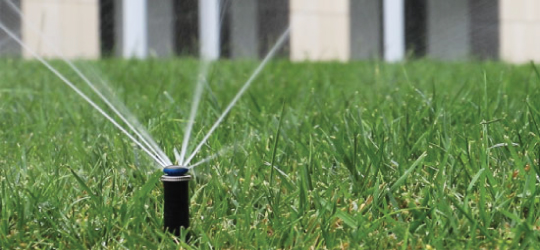
Water
UC Commitment
The University of California is committed to reducing growth-adjusted potable water consumption 36% by 2025, when compared to a three-year average baseline of FY 2005-06, FY 2006-07, and FY 2007-08.
Campus Water Conservation Efforts in Response to California Drought
The campus Water Action Plan calls for a minimum 4% increase in water conservation annually. New campus plans will accelerate this goal to achieve City of San Diego Water Use Restrictions. UC San Diego complies with all City of San Diego's year-round permanent mandatory restrictions in place. These restrictions aim to promote water conservation as a permanent way of life in San Diego.
In response to California and San Diego mandated water restrictions, Resource Management & Planning responded by stopping water leaks within 72 hours of notification, limiting watering hours and mandating use of recirculating pumps for decorative water fountains. We are also converting many turf areas to low/no-water-use landscape using drought-tolerant plants and groundcover.
Report Water Waste
If you see water waste on campus, please contact Facilities Management's Customer Relations help desk, (858) 534 2930.
Recycled Water Irrigation
With each new construction project, we install landscape recycled water piping. Expanded recycled water distribution throughout campus including landscape areas around School of Medicine, Central Utilities Plant, and Revelle Switch Station. Average annual recycled water irrigation has been approximately 40%.
- Current development and conversion projects will increase recycled water irrigation coverage to more than 50% of the campus.
- All UC San Diego Recreation Fields and surrounding landscapes are irrigated with recycled water.
- All of UC La Jolla Health landscape areas are irrigated by recycled water.
- Approximately half of Housing*Dining*Hospitality landscapes are irrigated with recycled water.
We also:
- Retrofitted nearly 7,900 standard sprinklers with high-efficiency rotating nozzles, saving 10 million gallons and $82,000 per year
- Use computer-controlled irrigation systems that adjust watering based on temperature and humidity and save an additional 55 million gallons annually
- Monitor soil moisture to target irrigation
Centralized Irrigation Control
UC San Diego Landscape Services is shifting to a more robust irrigation central control system called IQ4. Amongst the many system features, highlights include:
- Real-time accurate weather data from online sources to facilitate automatic schedule adjustments to reduce excess irrigation
- More reliable and sensitive flow monitoring that can shut down the system when a main line or lateral line breaks and send an email or text message alert to Landscape Services staff. Conventional systems do not register system breaks and water runs until someone sees and reports the break.
- Remote control via smartphone, reducing labor required for system inspections
All campus development projects and landscape renovations include specifications for irrigation controllers and communication devices that use the IQ4 platform. Technicians replace all failed irrigation controllers with a controller and communication device that utilizes the IQ4 platform.
Xeriscaping
UC San Diego plants low-water-use, native and drought-tolerant plants in 75% of the irrigated campus landscape and ensures compliance with California’s Model Water Efficiency Landscape Ordinance (MWELO). Environmentally sensitive landscape management also improves water and soil quality, promotes biological diversity and lessens our environmental impact.
Improving Efficiency
UC San Diego is conserving water by retrofitting existing buildings with low-flow devices and installing low-flow fixtures in residence halls. In new and recently retrofitted buildings, condensate-capture systems collect non-potable water from various building sources, filter and store it onsite for use in dual-plumbed toilets and landscape irrigation.
Eco-Friendly Cleaning Products
More than 74% of our cleaning products are certified by third-party eco-labels, such as UL ECOLOGO, Green Seal, EPA Safer Choice or meet EPA guidelines for post-consumer recycled content. These environmentally friendly products protect worker health and safety while improving gray water quality.
Storm Water Management
UC San Diego's Storm Water Management Program helps prevent water pollution and keeps our beaches clean by eliminating dry weather flow discharges and measurably reducing harmful pollutants (heavy metals, organics, bacteria and sediment) in urban and storm water runoff.